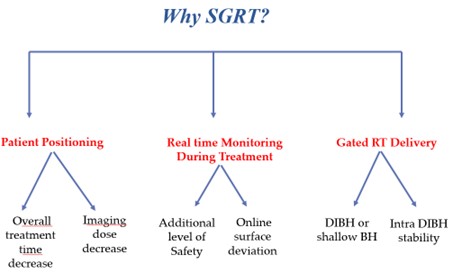Value of the Use of Surface-Guided Radiation Therapy in Radiation Oncology - PDF Version
Our primary goal in radiotherapy is to deliver the maximum dose to the tumour target in order to attack the cancer as far as possible, while minimising the dose to normal tissues to reduce the side effects. Uncertainties due to the patient's position or movement can be minimised through the use of image-guided radiotherapy. Advances in real-time, three-dimensional (3D) surface imaging systems have dramatically increased the use of surface-guided radiotherapy (SGRT) treatments in recent years. Although the initial motivation of the development of SGRT was to eliminate the need for three-point positioning and thus laser systems, it is now used in treatments because it offers many different advantages.
SGRT systems generally use a combination of a projector and single or multiple camera units to record the patient's 3D surfaces in real time. They use optical imaging to register these patient surfaces for comparison with a reference. Because the reference surface is defined relative to the treatment isocentre, the algorithms calculate the translations and rotations in six degrees of freedom. This process is necessary so that we can correct the patient’s position in real-time (1). Use of SGRT enables continuous monitoring of the patient’s position, thus improving patient safety and comfort, while also standardising workflows by providing increased precision/repeatability. In addition, its use has the potential to improve clinical outcomes as it helps with the delivery of planned high doses to the target volume and with the protection of normal tissue. In terms of patient positioning, SGRT is an effective tool to reduce overall treatment time and minimise imaging dose. SGRT is also used in clinics as an effective way to monitor respiration. In summary, SGRT is an important method, the use of which improves the overall accuracy of radiotherapy treatment in various steps (patient positioning, intra-fraction motion tracking, respiratory tracking, etc.) (Figure 1).

Figure 1. Clinical uses of SGRT and its advantages.
Various methods are used to monitor real-time intra-fraction movement. The choice of these depends on the state of its technological development.
Use of SGRT could improve clinical workflows beyond its current capabilities and reconfigure clinical practice. The implementation of SGRT in routine workflows poses challenges for radiation therapists; for instance, some applications must be altered. In many clinics, the need for tattoos is reduced or removed after SGRT implementation. Compared with three-point localisation, SGRT provides 3D visualisation of the patient’s posture and topographical information (2). The mean set-up time has been reported to be reduced by approximately one minute per treatment fraction during the use of SGRT compared with three-point localisation for patients undergoing partial breast irradiation (3). For superficial tumours (during treatment of which, surface deviations represent tumour motion), the number of daily scans can be reduced in some cases when SGRT is used. For more deeply located tumours (those in which there is no direct correlation between surface aberrations and tumour movement) daily imaging remains mandatory. With the use of SGRT, the time required for image registration and the need for multiple imaging can be reduced. SGRT is not a substitute for immobilisation, however; it remains very important to stabilise the patient throughout the treatment.
SGRT can also be used for intra-fraction monitoring in clinical workflows. The patient is monitored during the entire treatment, and in cases in which the patient's position moves beyond the specified tolerance values, the treatment is stopped automatically or manually and corrections are made. The use of real-time, intra-fraction monitoring with SGRT raises the safety standard for patient treatment. In breast radiotherapy, the deep inspired breath-hold (DIBH) method is generally used to remove the heart from the breast. In many clinics that do not have a motion management system, DIBH treatments can now be performed with SGRT and DIBH stability can be achieved easily.
SGRT systems will be increasingly used in our workflows in the future. With the application of SGRT, advances in the field, such as markerless tracking for four-dimensional image reconstruction, biometric patient identification, immobilisation device identification, in-room scene mapping, augmented reality and adaptive radiotherapy, will contribute to current treatment protocols (4). As radiation therapists, we should be involved in these studies and contribute to science in order to create the treatment protocols of the future.

Melis Gençtürk
Radiation Therapist
Anadolu Medical Center
Istanbul/Turkey
References:
- Al-Hallaq HA et al. AAPM task group report 302: Surface-guided radiotherapy. Medical Physics, 2022,49:e82–e112.
- Carl G et al. Optical Surface Scanning for Patient Positioning in Radiation Therapy: A Prospective Analysis of 1902 Fractions. Technol.Cancer.Res.Treat. 2018,17:1-9.
- Jimenez RB et al. Tattoo free setup for partial breast irradiation: A feasibility study. J Appl Clin Med Phys 2019,20:45-50.
- Batista V et al. Clinical paradigms and challenges in surface guided radiation therapy: Where do we go from here? Radiotherapy and Oncology 2020,153:34-42.